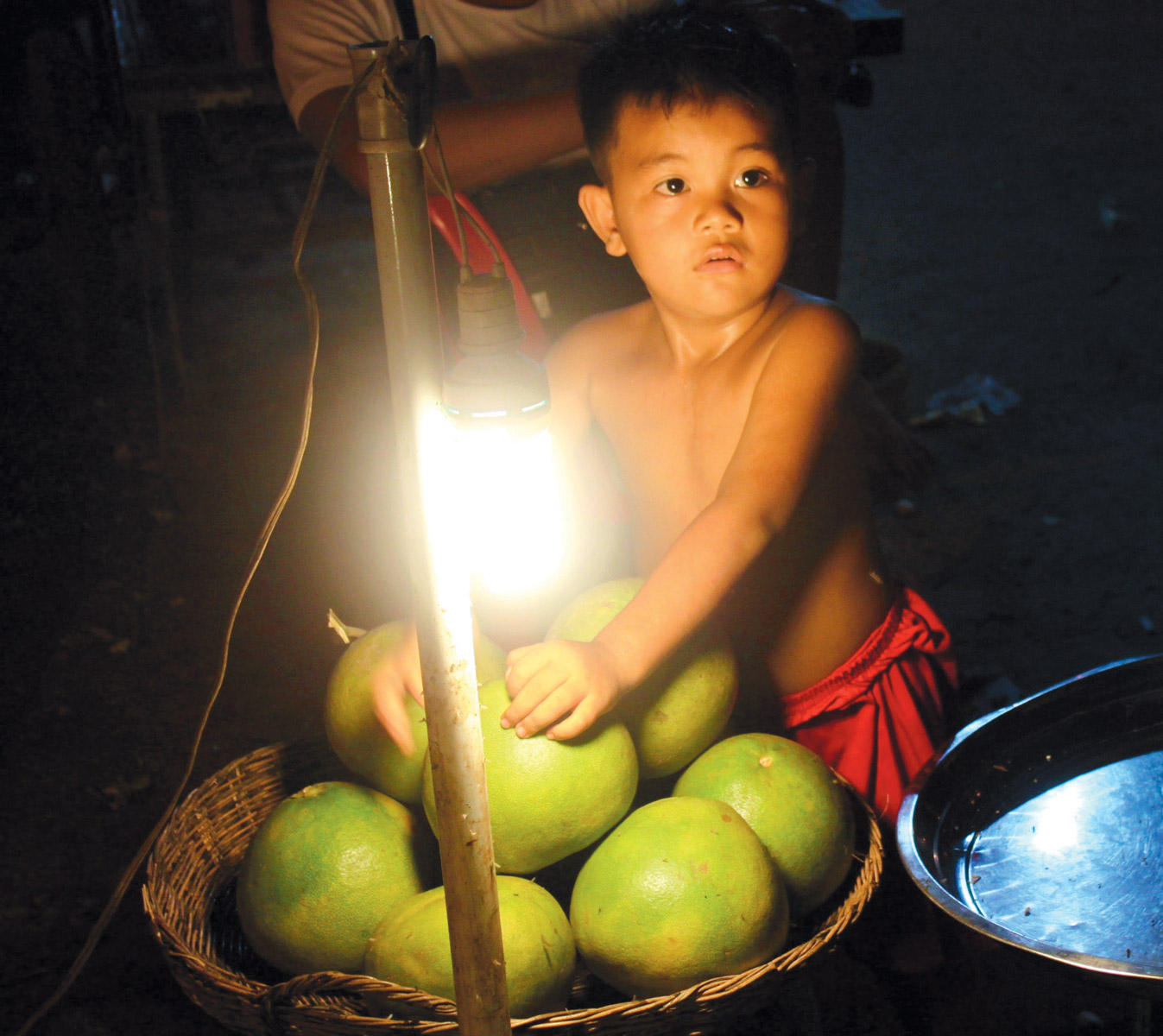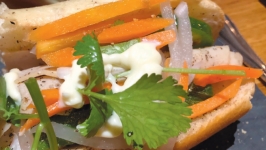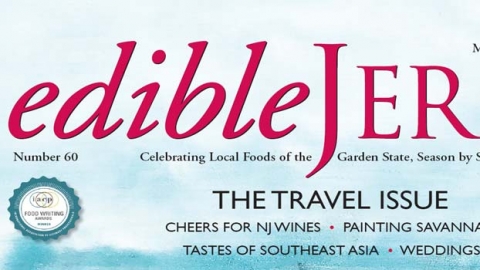Hanoi and Siem Reap - Food Tours in Vietnam and Cambodia
Food tours offer a uniquely local travel experience
Each cup is made with two eggs,” notes our enthusiastic guide, Ms. Moon, as she passes around short mugs of egg coffee. The top of each drink shimmers with a geometric design any barista would serve with pride. It is our final stop on a three-hour food tour through the bustling streets of Hanoi’s Old Quarter. Everyone is quite full. My wife manages only a sip. Our teenage son and our almost teenage daughter gamely try the strong Vietnamese coffee thickened with raw yolks. I still have a plastic cup of bia hói, Vietnam’s fresh beer, in one hand from the previous stop. I finish it. Then I finish the coffee. It would taste better with more of the sweet condensed milk the Vietnamese prefer in their coffee, but by this point I don’t want to disappoint Ms. Moon.
Hungry travelers looking to go beyond tourist-oriented dining options and learn more about the local cuisine should put a food tour on their next itinerary. Two food tours in Vietnam and Cambodia turned out to be highlights of our family trip to Southeast Asia.
Strong TripAdvisor reviews led us to the corner office of the Hanoi Street Food Tour. We had booked the 6:30pm walking tour the day before.
We usually avoid organized tours, preferring to explore destinations on our own. Everyone is an adventurous eater, however, and my kids are accustomed to my pesky food blogging habit, so we made an exception. At $20 per person, with food included, this was a low-risk outing.
The international crowd was divided into groups of 10. Our guide, Ms. Moon, a no-nonsense twenty-something, huddled us up, introduced herself and instructed us on the proper pedestrian technique for crossing the street. Namely, step off the curb into oncoming traffic, walk slowly and pray for the best. The cars and swarming motorbikes that never stop parted for us like slalom skiers racing downhill. We reached the first restaurant, a two-story storefront a few blocks away, without incident.
Over plates of bún cha, the Hanoi comfort food of grilled pork and fresh herbs atop thin rice vermicelli (famously shared by Anthony Bourdain and President Obama during his visit to Hanoi in 2016), Ms. Moon started with some rudimentary language instruction. Our group—the four of us, two Austrian guys, a woman from Iceland and three single American travelers—began to bond by failing dismally to pronounce correctly any tonal Vietnamese phrases. Ms. Moon delighted in our mispronunciations. She patiently repeated “thank you” and “one, two, three, cheers!” in Vietnamese so we could mangle each in turn.
An engaging tour guide makes all the difference. Ms. Moon proved to be witty, entertaining and informative. She delivered anecdotes about the healthful qualities of green papaya. She pointed to my “Buddha belly” and declared me a good eater. We learned from Ms. Moon that many street signs in Vietnam feature the word pho, not because there’s a soup spot on every corner (though that’s not far from the truth), but because one pronunciation of the word means “street.”

Cambodian papayas and mangosteens
Vietnamese cuisine is a big draw for visitors, with its delicate balance of flavors and textures, fresh local ingredients and food vendors on every corner. Hoping to try everything, an affliction of the food obsessed, I didn’t want to risk a bad meal. While food is all around you on the streets of Vietnam, a first-time visitor without basic language skills doesn’t know where to start or what to order.
Our group made seven stops and sampled 12 dishes on the Hanoi Food Tour. We wouldn’t have stopped at any of the food stands on our own. Each location on a looping route through the Old Quarter specialized in a different dish—bún cha, steamed rice spring rolls, deep fried specialties, mixed fruit salad, fresh beer and-bánh mì sandwiches. One of our favorites was the nôm bo, a salad of julienned green papaya served with bean sprouts, peanuts, beef jerky, beef slices, mint, lime and fish sauce. Each crunchy bite was simultaneously sweet, salty, savory, bitter and sour, a nice example of the balance that Vietnamese dishes can achieve.
What would have been daunting to navigate on our own went smoothly on the tour. All the vendors welcomed our group alongside their predominantly local customers. At a couple of stops that appeared to be sidewalk stands, we made our way inside to hidden tables. Food arrived without having to decipher the menu or point to our neighbor’s plates. Ms. Moon even managed vegetarian options at every stop for the Icelander, whom she quickly labeled “no-meat girl.”
At every stop, Ms. Moon, a Hanoi native, described what we were eating, added a bit of local context and showed us how to eat each dish. She pointed out the use of rice flour in Hanoi’s baguettes, giving the bánh mì there a distinctive lightness and shiny crust. For the bánh cuôn, delicate fermented rice batter crepes filled with minced pork and mushrooms, we learned to place a bitesize piece on a spoon filled with nuoc cham, topped with a sprig of Thai basil, before slurping it all down together.

Steven Halcrow inspects durians
I was impressed when our son volunteered to eat a fried tarantula. I was also terrified because this meant I had to try one.
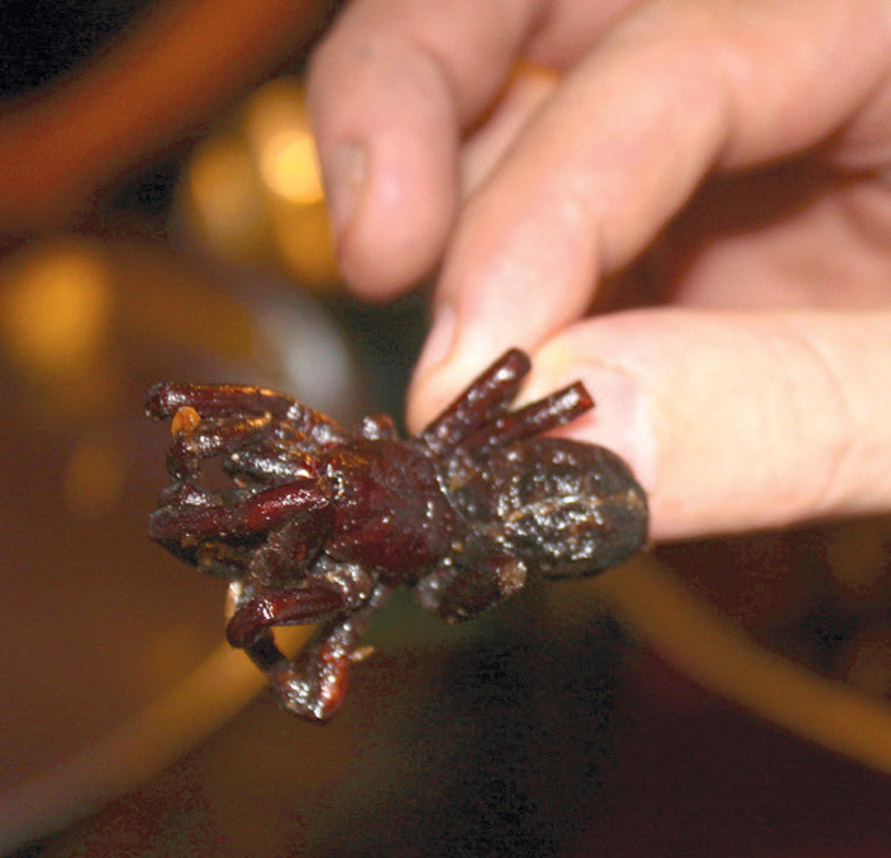
Grilled tarantula
Cambodia
A week later, we arrived in Cambodia. I had booked another evening food tour for our second night in Siem Reap, the town next to the UNESCO World Heritage Temples of Angkor. Siem Reap has a backpacker beach-town vibe, along a river instead of an ocean, with downtown streets full of souvenir shops, massage parlors and bars serving 50-cent draft beers. A food tour is a nice option, since restaurants serving true Khmer cuisine are hard to find in the tourist district.
Steven Halcrow met us at our hotel. A tall, blue-eyed Scotsman, Steven is obviously not local. He and his partner, Lina Goldberg, a food and travel writer from California, run Siem Reap Food Tours, featured in The New York Times. It was just our family on the tour that night. Steven asked about food allergies and said we would be stopping at restaurants beyond the touristy areas. Outside, a tuk tuk driver was waiting. We climbed into the two-wheeled taxi carriage attached to the motorbike; Steven hopped on behind the driver. Our first stop was on a commercial street at a restaurant specializing in fish amok—white-fleshed snakehead steamed in a banana leaf with a coconut-based, yellow curry broth. Cambodian cuisine features a lot of freshwater fish, thanks to the country’s bountiful lakes and rivers. Our bowls of fish amok were served with a shredded green mango salad (chruok svay) studded with specks of dried fish. The salty fish matched nicely with the sweet and sour mango. Steven included this restaurant on the tour because the chef doesn’t tone down the dishes for foreigners. He was right.
At a BBQ joint in a residential neighborhood, a whole roasted beef haunch hung over a charcoal grill. The woman manning the grill sliced off pieces of meat to finish on the grill before serving. Steven explained that even though local cattle are skinny compared to Western breeds, skilled Khmer butchers turn out tender cuts of meat. At the table, we were served a plate of grilled beef slices, cold vegetables under ice cubes, various condiments and bowls of the thick, brownish-gray prahok. By itself, the fermented fish sauce was pungent, like a garlicky, sour anchovy paste. To make a dipping sauce for the beef and vegetables, we mixed a bit of the prahok dipping sauce with diced lemongrass, chopped peanuts and a squirt of lime. The result was a delicious way to enjoy Cambodian BBQ, especially with a cold can of Angkor beer. We made five stops on this tour, sampling at least 10 dishes. These included num banh chok, the popular Khmer rice noodles served in a light, fish-based green curry tasting of lemongrass and kaffir lime. As with Vietnamese phợ and bún cha, we added fresh herbs (mint, bean sprouts, banana flower) at the table.
Steven is a recovering chef. For nine years he rose through some serious kitchens in his native Scotland, including the Michelin two-star restaurant, Andrew Fairlie. In Siem Reap, he has worked in the kitchen at Cuisine Wat Damnak, the highly rated French and Cambodian restaurant. Impressively, he speaks basic Khmer, which comes in handy at every stop. Steven’s culinary training was evident when he described the use of palm sugar to balance the salty, sour and bitter flavors in Khmer dishes, and when he reminisced about the black pudding he couldn’t find in the country. Steven thinks there could be a market for good black pudding in Cambodia. He would just need to find a reliable source of pig’s blood.
Our next stop was the night market. There’s one market in the center of Siem Reap’s tourist district, but back in the tuk tuk, we headed out of Siem Reap proper in the direction of the Angkor temple complex. Across from the park headquarters, where, during the day, there was nothing but an empty field, a double line of food stalls now stretched for a quarter mile. Families sat on blankets and tarps behind the stalls eating dinner. The street was filled with young Cambodians hanging out. A cluster of rickety amusement park rides illuminated the field. According to Steven, this local market emerges daily every evening. We never would have known this night market existed.
We visited one of the fried insect stalls. Our first thought was that the bugs must be a gimmicky snack aimed at tourists. But the night market in this part of town is clearly by Cambodians for Cambodians. Dishes born of food scarcity are common in Cambodia, which endured brutal deprivations under the Khmer Rouge regime from 1975–78 and decades of armed conflict as recently as the 1990s. Protein is protein. The insect stop is a litmus test of sorts for Steven’s tour groups. If you’re willing to crunch on some fried crickets or silkworms, he’s comfortable suggesting more adventurous dishes. I was impressed when our son volunteered to eat a fried tarantula. I was also terrified because this meant I had to try one. Turns out, tarantula is all about texture over taste. Biting into one is like crunching down on a piece of soft-shell crab with no discernible meat, just a hint of sweet and salt from the chicken powder glaze. We managed to chew, swallow and survive the tarantulas.
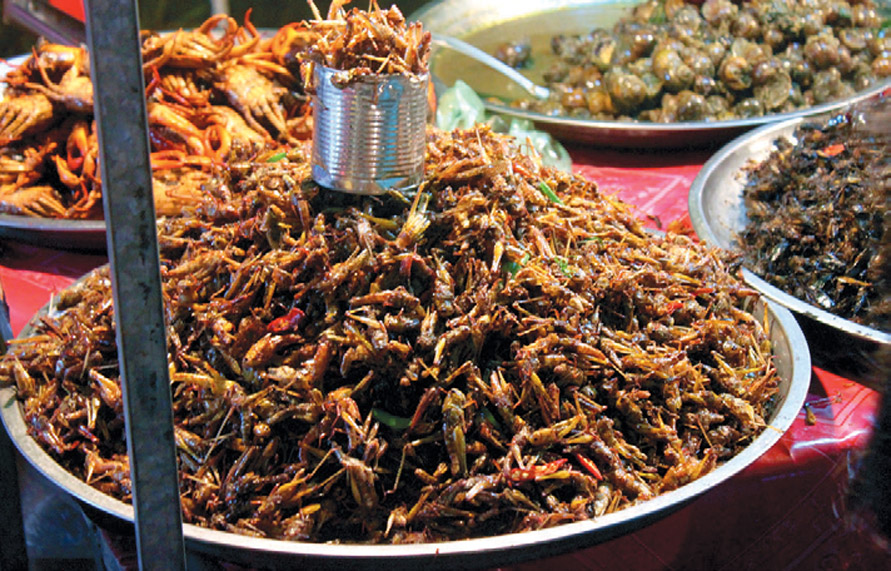
Grilled scorpions
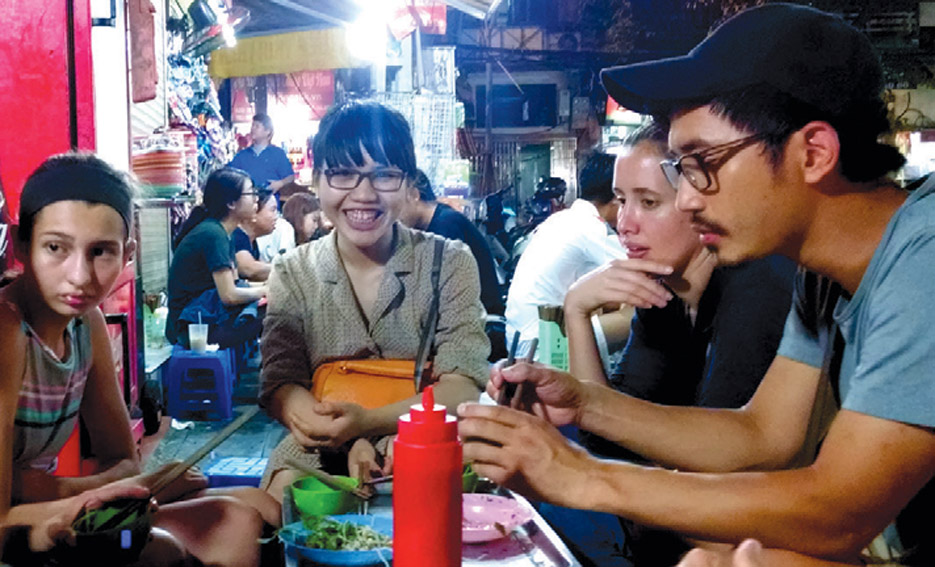
Ms. Moon leads our Hanoi Street Food Tour
Each crunchy bite was simultaneously sweet, salty, savory, bitter and sour, a nice example of the balance that Vietnamese dishes can achieve.

Freshly grilled frogs
Next stop was one of the many grilling stations. Steven steered us to his favorite, manned by the woman he considers the best cook among them. Steven pointed to what he wanted on the bamboo skewers arrayed across the grill: glistening, sizzling whole frogs. At a folding table behind the grilling station, Steven shared some hand sanitizer from his fanny pack and laid out the treats. There were skewers of barbecued pork and some sticky rice steamed in a grilled banana leaf, like a Latin American tamál. The star, and our favorite single bite of both food tours, however, was the grilled stuffed frog. You pluck off the legs and eat the meat like tiny chicken wings. The frog bodies had been emptied almost completely and filled with a sweet and spicy ground pork mixture. The crispy frog skin became an exotic sausage casing.
Steven asked if we were interested in trying fresh durian. Known in Cambodia as the “king of fruits,” durians have a reputation for provoking strong reactions, either love or disgust. A delicacy to some, others consider them the stinkiest fruit on the planet. The mature fruit, with an exterior covered in spiky skin, looks like an intimidatingly large pineapple. The odor is so strong you can easily smell the fruit before you peel it. Steven directed the tuk tuk driver to pull up alongside a roadside cart full of the pointy specimens. He intently smelled and tapped on each prospective fruit. He picked a good one. The vendor sliced it open and sectioned the white flesh into a Styrofoam container. Everyone in the back of the tuk tuk tried a piece. No one was repulsed. Nor could we agree on the exact flavor profile. I thought it tasted like mango, yeast and baby aspirin. My wife tasted custard and onions. The kids declared it goopy and “interesting.” Even if we couldn’t describe it, we’ll always remember eating it.
According to Steven, some Asian tour groups do visit the market, but he rarely sees Western visitors there. We encountered no other Western tourists. The night market was the highlight of the food tour.
Touring with an expat like Steven gave us the advantage of shared points of reference as foreigners encountering the local cuisine and context. Steven was quite candid describing his evolving response to the beggars common at the night market, for example, and the challenge of finding restaurants where servers won’t giggle or stare at foreigners eating the local food. The best guides share much more than the food. Steve loves the expat life, but mused about moving to California. “Would you cook again?” I asked. “Not in a restaurant. I’m thinking about a food truck.”
HANOI STREET FOOD TOUR (Vietnam)
hanoistreetfoodtour.com
74 Hang Bac Street, Hanoi
0966.960.188
hanoistreetfoodtour@gmail.com
SIEM REAP FOOD TOURS (Cambodia)
siemreapfoodtours.com
855.12.505.542
info@siemreapfoodtours.com


